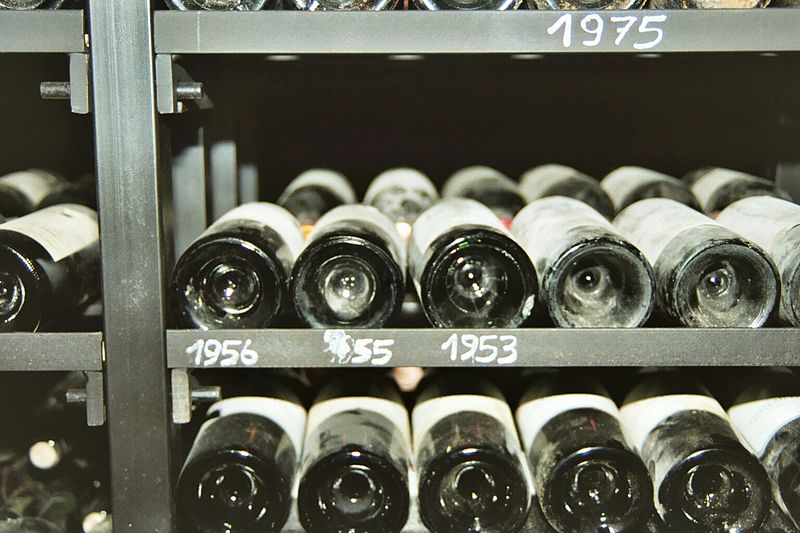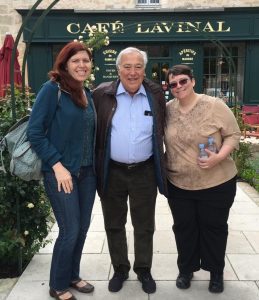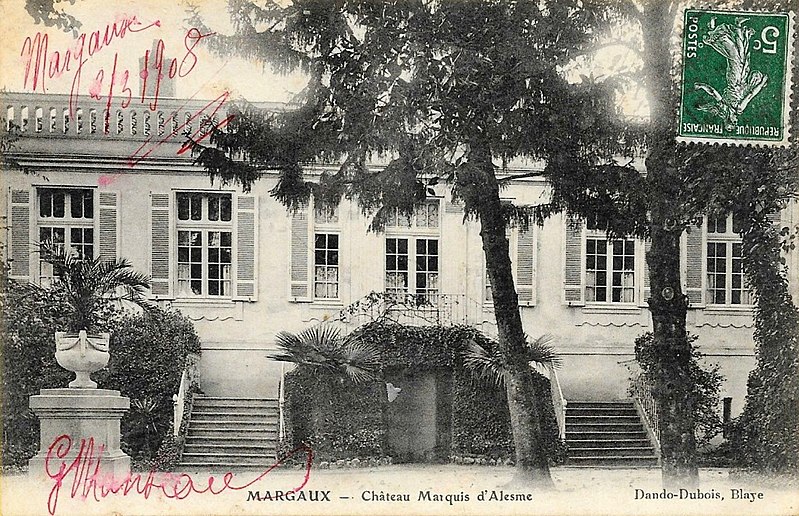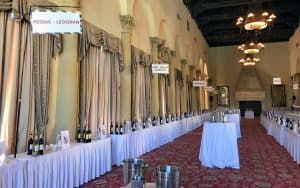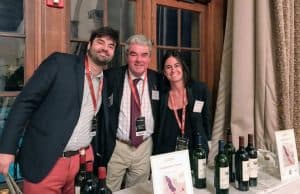I just returned from vacation and am working on my blogging calendar for 2019. As I plan my content goals for the year, I decided to take a look back at what I did in 2018.

Winemaker dinner with Chris Loeliger of TruthTeller Winery and the Wine Fool at the 2018 Wine Bloggers Conference.
Going through my Google Photos, this one jumped out to me as an apt summary of 2018.
While I technically started this blog back in 2016, I didn’t dedicate myself to full-time writing until last year. I spent a good chunk of 2018 feeling my way through and figuring out what I enjoyed writing about–as well as what resonated with readers. I’m a bit shocked at how much my traffic and subscription rate has jumped over these past 12 months and am very humbled by the support.
So as I look back on 2018, I’m also going to share a few of my thoughts on what content I’ll be producing going forward. The primary purpose of this blog will always be to serve as a study tool as I work on my WSET Diploma. But I am an inquisitive geek and a slutty boozer so it’s hard not to write about other alcohols that catch my attention. They also seem to grab the attention of readers (and search engines) as my top posts by traffic reveal.
The 8 Most Read Posts on SpitBucket for 2018
1) Apothic Brew Wine Review — Published on April 8, 2018
2) What We Know So Far About the Master Sommelier Cheating Scandal — Published on October 14, 2018
3) Johnnie Walker “White Walker” Limited Edition Scotch Review — Published on October 15, 2018
4) 60 Second Whiskey Review — Tullamore DEW Caribbean Rum Cask Finish — Published on March 9, 2018
5) Wine Clubs Done Right — Published on January 14, 2018
6) 60 Second Whiskey Review – Alexander Murray — Published on November 28, 2017
7) 60 Second Whiskey Reviews — Jameson Caskmates IPA edition — Published on January 20, 2018
8) Why I Buy Bordeaux Futures — Published on July 11, 2018
Some Thoughts

For several weeks after the MS scandal hits, folks were searching for details about Reggie Narito, the somm at the heart of the scandal
Screenshot from Narito’s public blog.
https://rnarito.wordpress.com/
I’m quite surprised by how much traffic I still get on the Alexander Murray whiskey review. I wrote that piece back in 2017 and get weekly, if not daily, hits on it. While I’m not very familiar with search engine optimization (and only recently learned about how readability plays into SEO rankings), it’s clear that a lot of people are searching for info on this relatively obscure independent bottler.
Likewise, the eruption of the Master Sommelier scandal drew big interest from search engines. I also benefited from having my article picked up by various news aggregators like Wine Industry Insight and Flipboard. Admittedly, Flipboard is a platform (like Pinterest) that I still haven’t figured out. I plan on spending some time this year learning more about them.
My early January post about deciding to join the Tablas Creek wine club took off when Jason Haas wrote about it on the Tablas Creek Vineyard Blog. I was very shocked and honored that Haas would even read, much less seriously consider, the viewpoints of a random blogger. But as I learned in my continuing journey as a wine club member, this is just par for the course with the Tablas Creek team’s outstanding engagement of their customers.
It’s clear that they are continually striving to improve and actively want to hear from consumers. They’re not hiding out in some ivory tower or behind a moat-like tasting bar. The folks at Tablas Creek make wine because they enjoy it and want to share that joy with others. This is a big reason why they, along with Rabbit Ridge, are one of the few wineries on Twitter that are worth following.
It’s not all Champagne and Bordeaux
Working at grocery stores and wine shops, you learn quickly that the vast majority of wine drinkers don’t necessarily drink the same things you enjoy. You can respond to that in two ways–get stuck up and snobbish about it or try to understand what makes wines like Apothic Brew or its whiskey barrel aged brethren appealing.

The fluorescent glow of Mamamango in the glass was a bit weird.
I prefer to take the latter approach which is why you’ll find me researching the backstory of wines like Apothic Brew, Capriccio Bubbly Sangria, Mamamango, Blanc de Bleu and non-alcoholic wines with just as much attention as I do for my reviews of Petrus, Lynch-Bages, Giscours, Krug Clos du Mesnil, Perrier-Jouët Belle Epoque or Louis XV Rose.
Going forward, I will continue my exploration of new wine trends that emerge. While I am sincerely dreading the advent of cannabis wine, I will nonetheless try it–for science.
A Few of My Favorite Posts from 2018
These articles might not have gotten the search engine traffic that my whiskey and other wine posts did, but they were ones that I had fun writing. They’re also the posts that I think most convey who I am as a wine writer and my general approach to wine.
January
Snooty or Flute-y? — Published on January 13, 2018
Champagne Masters and their Bull Shit — Published on January 22, 2018
Don’t Be a Jackass and Blindly Listen to Bloggers — Published on January 25, 2018
Thought Bubbles – How to Geek Out About Champagne — Published on January 29, 2018
Cab is King but for how long? — Published on January 31, 2018
So apparently I was a bit feisty back in January (and drinking a lot of Champagne). While I’ve always had little tolerance for know-it-alls or folks who dish out bad advice–my language is usually not that stark.
Still, I stand by those words I wrote back then regarding the ridiculous assertations of so-called “wine prophets” and bloggers who aim to stir anxiety and doubt in newbie wine drinkers. These folks don’t do anything to improve the dialogue around wine or promote exploration. They deserve to be taken down a peg or two. And I sincerely hope that if I ever stray that far that someone will come along and knock me down as well.
February-March
Under the (Social Media) Influence — Published on February 13, 2018
What’s fine (and not so fine) about Vegan Wines — Published on February 25, 2018
Wine Competitions — Should Wine Drinkers Care? — Published on February 28, 2018
The Mastery of Bob Betz — Published on March 5, 2018
Jancis Robinson — The Beyoncé of Wine — Published on March 8, 2018
The Legend of W.B. Bridgman — Published on March 31, 2018
As I mentioned in my note about the Apothic Brew review, being in the trenches in retail gives you a lot of insight that you don’t glean from wine books or blogs. The typical wine consumer thinks about wine in a completely different way than most wine writers. That experience fuels my skepticism about the true reach and influence of “influencers”.
I noted in a later post in November, What’s The Point In Writing Wine Reviews?, that I never once had a customer come up to me on the floor with blog review or seeking a wine that they said they saw on Instagram and Twitter. Never. In contrast, nearly every day I had customers looking for a wine they had at a restaurant. When major newspapers or magazines came out with their yearly “Best of…” lists, they were also far more likely to bring people in than a blog or social media posting.
In October, I may have annoyed my fellow bloggers at the Wine Blogger Conference when I told a few winemakers that if I were running a winery, I would focus more on the influencers at national and regional publications as well as getting my wine on by-the-glass programs at restaurants. I would also enter every wine competition I could find because, even though these competitions really shouldn’t have the influence that they do, consumers respond to seeing shiny medals on bottles.
Putting the Pieces Together

A highlight of my year was being invited to Betz Winery where I got a personal lesson on Washington State terroir by Bob Betz and head winemaker Louis Skinner.
Though the posts in March are genuinely some of my favorites. I love getting knee deep into the history of influential figures in wine. Wine lovers across the globe should know about people like Bob Betz, W.B. Bridgman and (in later articles) Martin Ray and Nathan Fay. The world of wine is a quilt with many people contributing to the stitches that keep it together. It’s easy to focus on the patches, but to understand the quiltwork, you have to look at the stitching.
My piece on Jancis Robinson, though, has a bit of a personal bent that goes beyond an academic profile. This one I keep prominently featured in my Author Bio because anyone wishing to understand who I am as a wine writer is well served by understanding the immeasurable influence that Jancis Robinson has had on my career.
April-June
Why I Don’t Use Scores — Published on April 4, 2018
Playing the Somm Game in Vegas — Published on May 7, 2018
Naked and Foolish — Published on May 21, 2018
Pink Washing in the Booze Industry for Pride Month — Published on June 24, 2018

Still can’t get over the jackpot I scored playing the Somm Game when I was in Las Vegas this past May.
It pretty much made up for the disappointment of the 2018 Wine Spectator Grand Tour.
I also keep a link to Why I Don’t Use Scores in my bio as it is an indelible part of my approach to reviewing wine. I know I’m sacrificing traffic and backlinks by not providing magical numbers that wineries can tweet about or feature on their sites. Likewise, I’m sure many PR firms scan over postings like this that convey my love/hate relationship with reviews only to close their browser tab quickly. Frankly, I could care less.
Perhaps it’s privilege in that, with my wife’s career, I don’t need to make an income from writing. I don’t need to count on a steady stream of free wine samples for topics to write about. Truthfully, I prefer paying for the wine that I review or the events I attend because I feel that it gives me a better grounding in measuring their value.
I rate with my wallet instead of with scores because that is how most regular wine consumers judge wine. Did the bottle give you enough pleasure to merit its cost? Great, that’s was a good bottle for you. It doesn’t matter what points it got from a critic. Nor how many stars it had on an easily gameable rating system (Naked and Foolish).
While as a blogger this view is thoroughly self-defeating, I can’t ever see myself straying from the mantra of “Ignore the noise (i.e. bloggers like me) and trust your palate”. I’m not here to tell you what you should buy or how you should drink. I’m just geeking out over whatever is tickling my fancy at one particular moment in time.
September-October
Birth Year Wine Myopics — Published on September 6, 2018
Zinfandel — The “Craft Beer” of American Wine — Published on September 11, 2018
The Fanatical But Forgotten Legacy of Martin Ray — Published on September 29, 2018
The Wine Industry’s Reckoning With Millennials — Published on October 8, 2018
Race From The Bottom — How Should Wine Regions Break Into New Markets? — Published on October 25, 2018
A drum that I will continue to beat loudly in my writings is that the biggest threat to the wine industry over the next several years will be the “Boredom Factor” of the next generation. In 2019, Millennials will outnumber Baby Boomers as the largest demographic in the US. As I touched on back in my January post Cab is King but for how long? and in The Wine Industry’s Reckoning With Millennials, wineries are foolish to rest their laurels on the old-standbys of Cabernet Sauvignon and Chardonnay.
Millennials crave new experiences and are notorious for getting bored quickly. We crave uniqueness and distinction. As the influence of Baby Boomers and Gen Xers fade from dominance, wineries are going to have to figure out how to stand out from the pack of “same ole, same ole.” The wineries and wine regions that aren’t planning for this (or, worse, doubling down on the old guard) are going to struggle mightily.
November

Pitting these Joe Wagner wines against various Oregon Pinot noirs in a blind tasting yielded some surprising results.
Wine Media Musings — Published on November 9, 2018
Viva La Vida New Zealand — The Coldplay of the wine world? — Published on November 13, 2018
What’s The Point In Writing Wine Reviews? — Published on November 15, 2018
Joe Wagner vs the Oregon Volcano — Published on November 30, 2018
While I’m coming around to the Wine Bloggers Conference’s name change to Wine Media Conference, I still hold a lot of the same sentiments I expressed in Wine Media Musings. The mantra Show, Don’t Tell is another one that I’m not likely to abandon. I see little need to puff up my credentials or try to claim a title of “Wine Media” for myself. I’m a writer. I’m a communicator. But ultimately it will be readers like you who decide what is Wine Media and what is just noise. My job is merely to put my head down, do my due diligence and work, and create content that will hopefully show that it’s credible and original.
December
The Hits, Misses and Mehs of Wine Reviews — Published on December 10, 2018
Stop Scaring the Newbies — A Look at the Wine Hierarchy of Needs — Published on December 16, 2018
Winery Tasting Notes Done Right — Published on December 17, 2018
Nathan Fay’s Leap of Faith — Published on December 31, 2018

The Wine Hierarchy of Needs.
Original image from Bitcoin & Maslow’s Hierarchy of Needs. Drawing by Kenneth buddha Jeans with text added.
I’ll try to make a New Year’s resolution to stop writing about wine reviews for 2019. But I will say that posts like The Hits, Misses and Mehs of Wine Reviews have done a lot to solidify in my mind just what the hell I’m doing here. Even though I often draw on my experiences working retail, at restaurants and wineries for posts, at my core, I’m just a regular wine consumer like most of you. It’ll always be hard to separate from that mindset when I deal with wine reviews as well as winery tasting notes.
While there are aspects of those things that are undoubtedly helpful for consumers making buying decisions–a lot of it is also a heap of bullshit. (Sorry, must be a January-thing)
Finally, two of these year-end posts–the Wine Hierarchy of Needs and my piece on Nathan Fay–were my absolute favorites posts that I’ve written on this blog to date. It felt good to end the year on a high note.
My Favorite 60 Second Reviews of 2018
I went back and forth about whether or not I wanted to do a Top Wines of the Year post. Ultimately I decided against it for a few reasons. For one, I haven’t yet published my reviews on all the great wines I had last year–especially from the past three months. While I have my tasting notes written down, the Geekery sections take longer to do because I’m a stickler for research and fact-checking. I want to find multiple sources beyond just a winery’s website for details I publish. This means that many of the wines I review are ones that I might have had several days or weeks prior. (I do consider that when I make verdict calls relating to a wine’s aging potential or pratfalls.)
The second reason is that I don’t want this blog to be all about reviews. In general, I try to post reviews only around 2 to 3 times a week with the bulk of my articles being on other wine topics. For me, it will always be about the Geekery section. So while I will likely do 60 Second reviews in 2019 with the same frequency as last year, I may turn more of them into Getting Geeky with… posts.
With that said, this list below is not necessarily my favorite wines of the year (though many of them were excellent) but of the posts that I had the most fun researching for the Geekery section.

I learned a lot about Beaucastel’s approach to blending while researching this post.
Winderlea Shea Pinot noir — Published on January 29, 2018
Pierre Gerbais L’Originale — Published on January 31, 2018
Domaine Coquard Loison Fleurot Chambolle-Musigny — Published on February 28, 2018
Guardian Newsprint Cabernet Sauvignon — Published on March 14, 2018
Gorman Evil Twin — Published on March 15, 2018
2000 Beaucastel Châteauneuf-du-Pape — Published on April 9, 2018
2004 Nicolas Joly Coulée de Serrant — Published on April 21, 2018
Domaine des Pins St. Amour Les Pierres — Published on April 23, 2018
WillaKenzie Pinot blanc — Published on May 8, 2018
2007 Efeste Final-Final — Published on August 22, 2018
Adobe Road Bavarian Lion Cabernet Sauvignon — Published on September 28, 2018
Ch. de la Perriere Brouilly — Published on October 9, 2018
DeLille 2015 Rose (Can Rosés Age?) — Published on October 17, 2018
La Rioja Alta Gran Reserva 904 — Published on November 17, 2018
Accordini Ripasso — Published on November 19, 2018
Speaking of Getting Geeky
Few posts convey the spirit and focus of SpitBucket more than my Getting Geeky and Geek Notes features. Here is where I get down and dirty with the type of material that wine students pursuing higher levels of wine certification should aim to master. They make up a good chunk of the 350+ posts that I’ve written so far so I will narrow this down to just my ten favorites of each from this past year.
Getting Geeky with Domaine du Grangeon Chatus — Published on February 18, 2018
Getting Geeky with Soaring Rooster Rose of Counoise — Published on March 7, 2018
Getting Geeky with Gramercy Picpoul — Published on March 19, 2018
Getting Geeky with Henri Gouges La Perrière White Pinot — Published on April 6, 2018
Getting Geeky about Malbec — Published on April 17, 2018
Getting Geeky with Davenport Cellars Ciel du Cheval Rosé of Sangiovese — Published on August 4, 2018
Getting Geeky with Robert Ramsay Mourvèdre — Published on August 17, 2018
Getting Geeky with Otis Kenyon Roussanne — Published on August 25, 2018
Getting Geeky with Rabbit Ridge Petit Verdot — Published on October 13, 2018
Getting Geeky with Welsh Family Wines Blaufränkisch — Published on October 21, 2018
Geek Notes
This section changed focus in the latter half of the year. Previously, I used Geek Notes as a curated news feed featuring interesting weblinks with added commentary. After attending the Wine Bloggers/Media Conference in October, I realized that I needed to come up with a game plan for my social media channels. I moved the curated new feed over to the SpitBucket Facebook page and refocused Geek Notes to highlight useful study aides like podcasts, maps, videos and books for wine students.
Out of all the features that I do on the blog, this is the area that I will be increasing the frequency of my postings the most for 2019.

A section of the Grand Crus of Barolo map with the full version at http://www.jdemeven.cz/wine/Barolo_map.pdf
Killer Clos Vougeot Map — Published on January 9, 2018
I’ll Drink To That! Episode 331 Featuring Greg Harrington — Published on August 23, 2018
UK Wine Show Episode 111 with Ian D’Agata — Published on September 23, 2018
Super Cool Map of Barolo Crus — Published on September 30, 2018
Grape Radio Episode 391 Interview with Hubert de Boüard of Ch. Angélus — Published on October 10, 2018
Insider’s Peek Into Champagne — Published on November 7, 2018
Top Audiobooks on California Wine History — Published on November 11, 2018
Five Essential Books On Champagne — Published on December 5, 2018
The Process of Champagne GuildSomm Podcast — Published on December 8, 2018
More Champagne with GuildSomm Podcast — Published on December 22, 2018
Additionally, in 2018 I launched my Keeping up with the Joneses in Burgundy series which dives into the family lineage and connection of Burgundy estates. I started with the Boillot family and have completed cheat sheets on the Morey, Gros, Coche and Leflaive families as well. I will definitely continue producing more of these posts over the next several months.
Wine Events of 2018 and Some Personal News
Last year I had the opportunity to attend many fun wine events. Some were great (like the Wine Bloggers/Media Conference and Hospice du Rhone) while others (like the most recent Wine Spectator Grand Tour and Taste Washington’s New Vintage) were a bit of a dud.

Meeting Master of Wine Morgan Twain-Peterson of Bedrock at the Hospice du Rhone was another highlight of the year for me.
Walla Walla Musings — Published on February 15, 2018
Quilceda Creek Release Party — Published on March 18, 2018
Event Review — The New Vintage at Taste Washington — Published on March 27, 2018
Event Review — Washington vs The World Seminar — Published on March 29, 2018
Event Review — Stags’ Leap Winery Dinner — Published on April 22, 2018
Hospice du Rhône Weekend 2018 — Published on April 30, 2018
Déjà Vu at the Wine Spectator Grand Tour — Published on June 2, 2018
Getting Ready (and a bit nervous) For WBC18! — Published on October 3, 2018
My schedule of events for 2019 will be quite a bit different from last year. My wife and I are moving to Paris sometime in March as she takes on a new job opportunity in France. I will be making frequent trips back to the US to see family and work on a research project about the Stags Leap District AVA. But I’m not sure which events I’ll be able to attend–at least in the United States.
I do have my tickets already booked for the 2019 Wine Media Conference in the Hunter Valley this October, so that is a definite. I will also be transferring my WSET Diploma course work to London for an online/intensive classroom block schedule. This will give me a chance to explore some of the various wine events going on that side of the pond. Stay tuned!
Bordeaux Futures Posts

While I’ll likely never score as great of a deal as I did for the 2015 Ch. Margaux, I’ll still be a regular buyer of Bordeaux futures.
I started my coverage of the 2017 Bordeaux Futures campaign on May 1st of last year with an examination of the offers on Ch. Palmer, Valandraud, Fombrauge and Haut-Batailley. I completed 15 more posts, covering the offers of 64 chateaux, before it got too late into the year for futures offers to be relevant.
While my post Why I Buy Bordeaux Futures was one of my most popular of the year, admittedly I’m not certain if I want to continue this series with coverage on the 2018 campaign. These posts take a considerable amount of time to research and write and, overall, they don’t seem to get much readership.
But I will still be buying futures and doing this research on my own. I’ll likely do a modified version of the series in more of a summary format of the offers. I don’t need to necessarily repeat the geekery sections for each estate. I can shift that focus to individual Getting Geeky with... posts as I did for the 2007 Léoville Poyferré and 2008 Sarget de Gruaud-Larose.
However, if you were a fan of my coverage on the 2017 Bordeaux Futures campaign, I would love to get some feedback in the comments below.
Book Reviews
One area that I want to make a commitment to work on is posting more book reviews of useful wine books. Last year I only completed four.
Bursting Bubbles: A Secret History of Champagne and the Rise of the Great Growers by Robert Walters — Published on January 16, 2018
Rosé Wine: The Guide to Drinking Pink by Jennifer Simonetti-Bryan — Published on January 27, 2018
Washington Wines and Wineries: The Essential Guide by Paul Gregutt — Published on March 15, 2018
Oregon Wine Country Stories: Decoding the Grape by Kenneth Friedenreich — Published on August 20, 2018
While these are a bit of work, they are a lot of fun to write. I’m such a bibliophile that few things give me more joy than a highlighter and a good wine book. Writing these reviews is a way for me to relieve the delight of discovery I had when I first read them. They’re also terrific learning tools as I inevitably pick up something new (as I did with Oregon Wine Country Stories) when I go back to the text to write a review.
I’m going to set a goal of posting at least one book review a month for 2019. Some of these may be new books but most will probably be old favorites that I feel are particularly of benefit for wine students. I also enjoy putting together the Geek Notes for the Five Essential Books On Champagne and will continue that this year with listings of essential books on Bordeaux, Burgundy, Italian Wine, Winemaking and more.
Onto 2019!
So that is my look back at 2018 and thoughts for this year. Thank you to everyone who has subscribed as well as follow me on Twitter, Facebook and Instagram. I had a lot of fun last year and look forward to more geeking in 2019!

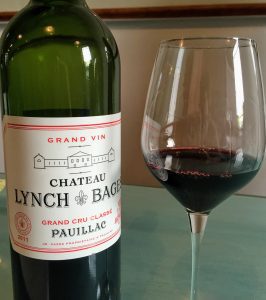

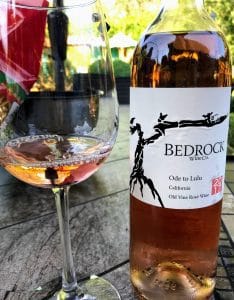
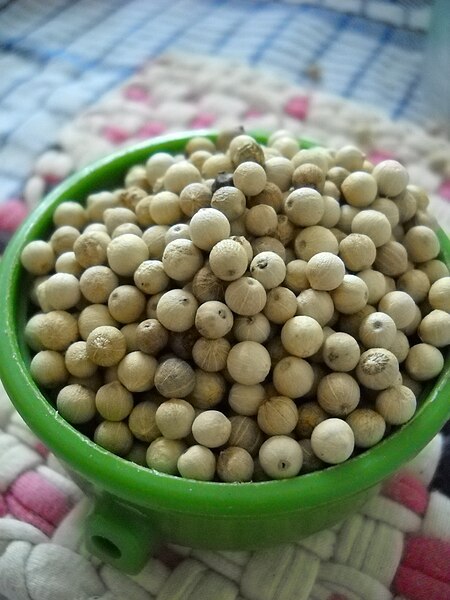
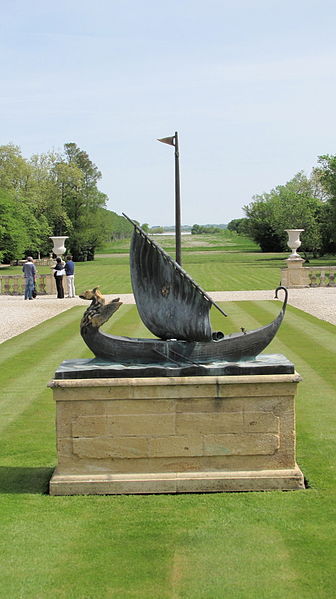 After hitting Pessac-Léognan in
After hitting Pessac-Léognan in 




